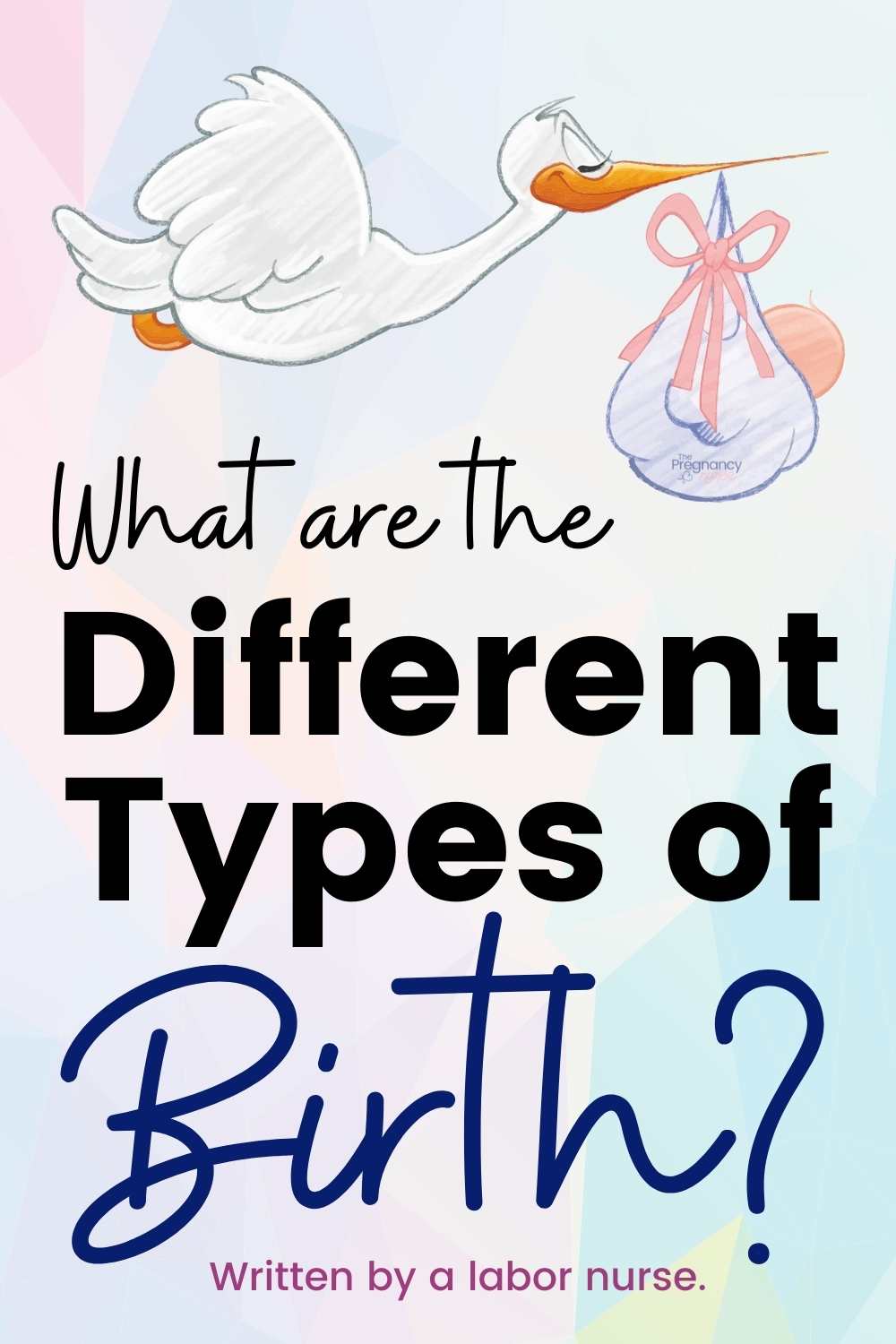People define different types of childbirth in many ways. Today I wanted to define the basic types that most people use — just so you understand where they are coming from.
Please remember that all of these different “types of childbirth” are childbirth. There is no reason to differentiate them as giving birth and “not giving birth”. Birth comes in all shapes and sizes, and for that, I’m grateful.
But, before we start — how do I know all of this?
Hi, I’m Hilary — The Pregnancy Nurse 👩⚕️. I have been a nurse since 1997 and I have 20 years of OB nursing experience, I am also the curly head behind Pulling Curls and The Online Prenatal Class for Couples. 🩺 I have helped thousands of families have their baby, and now I’m helping millions of families online. I have seen many different types of childbirth, and can give you insight into each one!
Grab my hospital packing list before we get started:
Types of Childbirth
- Natural Childbirth
- Medicated Childbirth
- Home Birth
- Free Birth
- Birth Center Birth
- Hospital Birth
- Midwife Birth
- Cesarean Section
- Induction Birth
- Augmented Birth
- Lotus Birth
Ok, now that we’ve listed those out — let’s define each one:
“Natural Childbirth”
Most people define this as having no pain relievers, although some people define it as having no medication during your birth.
Please note that MOST people are given pitocin after delivery to help with bleeding (even in “natural” childbirth) — especially once they understand the risks and the benefits of it.
Medicated Childbirth
Most people term this as people who have had some sort of analgesia during birth. The most often ones used are:
- IV pain medication
- Epidural analgesia
- Nitrous Oxide (not available at most hospitals in the US yet)
And yes, The Online Prenatal Class for Couples has an entire chapter on pain relief (and a bonus video on natural pain relief) — so, if you want to know more about those three, join us in there!
Home Birth
This would be a birth that is given at home. Most often these are planned, and assisted by a midwife. However, sometimes birth takes people by surprise and they give birth at home without planning on it (and then call the ambulance to take them to the hospital).
Failed Home Birth
I don’t like this phrase, but it just means a home birth that had to be transferred to the hospital. Most often we use “attemped home birth” but — it does mean that the birth team ultimately decides the hospital is safer/better at this point.
23-37% of attempted home births will end-up delivering at the hospital — so this clearly isn’t a failure at all. Just a change in location.
Free Birth
This is a birth where no one is there to assist the couple. The partner may or may not be there, but no trained doctor or midwife is present at the birth.
I have never seen this, and it makes me very nervous. I actually don’t even like to have the husband of the wife having the baby be the doctor of the delivery.
Birth Center Birth
This is where the baby is born in a birth center. Most often these are not attached to a hospital (but may be affiliated with them for a quick transfer). However, medical staff are there, and they have more equipment there if necessary.
However, these facilities can not do a cesarean section, or any after birth surgery. Any of those needs would need to be transferred to an accepting hospital.
Most often it is Midwives (either lay, certified, or nurse) who staff these.
Hospital Birth
Babies who are born in the hospital.
I actually have rates of how many babies are born where, in my birth statistics post.
I also have the #1 hospital-based childbirth class for couples on the internet for you RIGHT here. Come get prepared today!
Looking to get prepare for your birth? I have some easy options for you!
~~~~~~~~
– Worried you’re missing something? Grab my pregnancy planner so you don’t miss a thing!
– Thinking about an induction? Grab Inductions Made Easy to feel prepared in just 20 minutes!
– Wondering how to get that baby OUT? Grab Going Into Labor Made Easy so you know how to (and not to) do it!
– Postpartum got you anxious? Check out Postpartum Care Made Easy so you can stay SAFE even when all your attention is on that little on.
🚨 AND if ALL OF IT has got you on edge The Online Prenatal Class for Couples is perfect for you — You’ll feel so ready before you even know it!
~~~~~~~~
No matter WHERE you are at in your pregnancy journey, we have resources that can help!
Midwife Birth
This is one where a midwife assists in the delivery. Please note that there are several kinds of midwives (all with different training)
- Lay midwives — have had some training, although it is just done in the field with no actual program involved.
- Lisenced Midwife — have been through a midwife training and are lisenced (laws and regulations exist for these, which they must follow).
- Certified Nurse Midwife — Has a masters or phD level program, followed by a type of “residency”. They must also take an exam to certify. These can deliver in the hospital, homes (depending on the state) or a birth center.
Cesarean Section
Birth in which the baby is cut out through surgery. I have a post on my sister site with 15 awesome C-section facts that can help you learn more about that.
And yes, I think it’s SO important all expecting families know about this, I have a whole chapter in my class on it. SO many couples have been SO thankful they took a class with someone who had a lot of experience with ALL types of birth!
Unplanned Cesarean
This is when the baby is born by cesarean, but it wasn’t planned when they were admitted into labor and delivery. Something, during the labor, made it so a cesarean seemed like the best choice at that point
Emergency Cesarean
When an emergency situation exists and the patient has to have a cesarean NOW.
Most often this is given with general anesthesia, and the hospital staff is trained to have baby out within 5-15 minutes.
Induction Birth
When labor doesn’t start naturally, but instead is started through medical interventions including:
- Mechanical — using a foley bulb, or breaking your water.
- Cervical Ripening Medications, like Cytotec or Cervidil.
- Pitocin .
And before you wonder, my class also has a whole chapter on inductions!
Augmented Birth
This is one where the patient was in labor, but it was moving slowly, so the addition of (most often) Pitocin was given to speed things up a bit.
The reason/need to speed things up can be a variety of reasons.
Lotus Birth
At delivery the placenta is not removed from the baby (normally, it is cut off after being clamped). Instead, the placenta stays on until the cord falls off (usually 5-10 days).
Ok, that’s all I could think of. I’d love to know if I missed any — tell me in the comments!
No matter WHAT type of birth you’re aiming for, studies show you’re going to enjoy it more if you take a childbirth class. Come join The Online Prenatal Class for Couples today! Do it in just a few hours, and with 3 price points it can fit your budget too!
Want to do a vibe check before diving into the whole thing with me? — check out my free labor pro tips. It’s your first step toward getting in the driver’s seat of your birth.
Were any of these types of birth new to you? What type of birth are you planning on having? Are you prepared for a possible change from your plan? Tell me about it in the comments.








 What Pregnant Women Fear During Birth – Original Research
What Pregnant Women Fear During Birth – Original Research

[…] it’s a good idea to have a grasp of ALL types of labors — check out my post on the different types of birth). It’s important to know what to expect during each type of delivery, as well as the risks […]